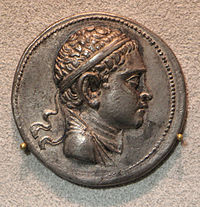Euthydemus II
| Euthydemus II | |
|---|---|
 Portrait of young Euthydemus II. | |
| Reign | c. 180 BC |
| Predecessor | Demetrius I |
| Successor | Eucratides I |
| Born | c. 200 BC |
| Died | c. 180 BC Bactria |
| House | Euthydemid |
| Father | Demetrius I |
| Mother | Daughter of Antiochus III |

Silver coin of King Euthydemus II. With Greek legend ΒΑΣΙΛΕΩΣ ΕΥΘΥΔΗΜΟΥ, "Of King Euthydemus".

Euthydemos II (185-180 BCE). With Greek legend ΒΑΣΙΛΕΩΣ ΕΥΘΥΔΗΜΟΥ, "Of King Euthydemus".
Euthydemus II (Greek: Εὐθύδημος Β΄) was a Graeco-Bactrian king; the son of Demetrius I of Bactria, he became king in the 180s BCE, either after his father's death or as a sub-king to him. The style and rare nickel alloys of his coins associates him closely in time with the king Agathocles but their precise relation remains uncertain. Euthydemus is pictured as a boy on his coins and most likely died very young.
He was the last Euthydemid ruler of the Greco-Bactrian Kingdom.
See also[]
- Greco-Bactrian Kingdom
- Seleucid Empire
- Greco-Buddhism
- Indo-Scythians
- Indo-Parthian Kingdom
- Kushan Empire
Notes[]
References[]
- The Greeks in Bactria and India, W. W. Tarn, Cambridge University Press.
External links[]
| Greco-Bactrian kings | Indo-Greek kings | |||||||||||
| Territories/ dates |
West Bactria | East Bactria | Paropamisade |
Arachosia | Gandhara | Western Punjab | Eastern Punjab | Mathura[2] | ||||
| 326-325 BCE | Campaigns of Alexander the Great in India | Nanda Empire | ||||||||||
| 312 BCE | Creation of the Seleucid Empire | Creation of the Maurya Empire | ||||||||||
| 305 BCE | Seleucid Empire after Mauryan war | Maurya Empire | ||||||||||
| 280 BCE | Foundation of Ai-Khanoum | |||||||||||
| 255–239 BCE | Independence of the Greco-Bactrian kingdom Diodotus I |
Emperor Ashoka (268-232) | ||||||||||
| 239–223 BCE | Diodotus II | |||||||||||
| 230–200 BCE | Euthydemus I | |||||||||||
| 200–190 BCE | Demetrius I | Sunga Empire | ||||||||||
| 190-185 BCE | Euthydemus II | |||||||||||
| 190–180 BCE | Agathocles | Pantaleon | ||||||||||
| 185–170 BCE | Antimachus I | |||||||||||
| 180–160 BCE | Apollodotus I | |||||||||||
| 175–170 BCE | Demetrius II | |||||||||||
| 160–155 BCE | Antimachus II | |||||||||||
| 170–145 BCE | Eucratides I | |||||||||||
| 155–130 BCE | Yuezhi occupation, loss of Ai-Khanoum |
Eucratides II Plato Heliocles I |
Menander I | |||||||||
| 130–120 BCE | Yuezhi occupation | Zoilos I | Agathokleia | Yavanarajya inscription | ||||||||
| 120–110 BCE | Lysias | Strato I | ||||||||||
| 110–100 BCE | Antialcidas | Heliokles II | ||||||||||
| 100 BCE | Polyxenos | Demetrius III | ||||||||||
| 100–95 BCE | Philoxenus | |||||||||||
| 95–90 BCE | Diomedes | Amyntas | Epander | |||||||||
| 90 BCE | Theophilos | Peukolaos | Thraso | |||||||||
| 90–85 BCE | Nicias | Menander II | Artemidoros | |||||||||
| 90–70 BCE | Hermaeus | Archebius | ||||||||||
| Yuezhi occupation | Maues (Indo-Scythian) | |||||||||||
| 75–70 BCE | Vonones | Telephos | Apollodotus II | |||||||||
| 65–55 BCE | Spalirises | Hippostratos | Dionysios | |||||||||
| 55–35 BCE | Azes I (Indo-Scythians) | Zoilos II | ||||||||||
| 55–35 BCE | Vijayamitra/ Azilises | Apollophanes | ||||||||||
| 25 BCE – 10 CE | Gondophares | Zeionises | Kharahostes | Strato II Strato III |
||||||||
| Gondophares (Indo-Parthian) | Rajuvula (Indo-Scythian) | |||||||||||
| Kujula Kadphises (Kushan Empire) | Bhadayasa (Indo-Scythian) |
Sodasa (Indo-Scythian) | ||||||||||
- ^ O. Bopearachchi, "Monnaies gréco-bactriennes et indo-grecques, Catalogue raisonné", Bibliothèque Nationale, Paris, 1991, p.453
- ^ Quintanilla, Sonya Rhie (2 April 2019). "History of Early Stone Sculpture at Mathura: Ca. 150 BCE - 100 CE". BRILL – via Google Books.
Categories:
- Indo-Greek kings
- 2nd-century BC rulers in Asia